Archives
- 2011/09/22Day 32 of shooting
- 2011/09/21Day 31 of shooting
- 2011/09/20Day 30 of shooting
- 2011/09/08Day 29 of shooting
- 2011/09/07Day 28 of shooting
- 2011/09/06Day 27 of shooting
- 2011/09/05Day 26 of shooting
- 2011/09/04Day 25 of shooting
- 2011/09/03Day 24 of shooting
- 2011/09/02Day 23 of shooting
- 2011/09/01Day 22 of shooting
- 2011/08/30Day 21 of shooting
- 2011/08/29Day 20 of shooting
- 2011/08/28Day 19 of shooting
- 2011/08/27Day 18 of shooting
- 2011/08/26Day 17 of shooting
- 2011/08/25Break in the shooting
- 2011/08/24Day 16 of shooting
- 2011/08/23Day 15 of shooting
- 2011/08/22Day 14 of shooting
- 2011/08/21Day 13 of shooting
- 2011/08/20Day 12 of shooting
- 2011/08/19Day 11 of shooting
- 2011/08/18Day 10 of shooting
- 2011/08/17Day 9 of shooting
- 2011/08/16Day 8 of shooting
- 2011/08/15Day 7 of shooting
- 2011/08/14Break in the shooting
- 2011/08/13Day 6 of shooting
- 2011/08/12Day 5 of shooting
- 2011/08/11Day 4 of shooting
- 2011/08/10Day 3 of shooting
- 2011/08/09Day 2 of shooting
- 2011/08/08The 1st day of shooting
- 2011/08/04All staff meeting
The basis for what would become the live action film Jellyfish Eyes was developed after I first opened an animation studio in Daikan Yama. The project was to be the studio’s modus operandi, a feature film animation. The idea developed from conversations I had at the time with a cactus breeder who lived in the Saitama town of Okuji, near Yori, the last station on the Tobu Tojo line.
This breeder’s main living was made as an insurance salesman. It turns out that there are a lot of Brazilian laborers who live in Gunma Prefecture and most of them are without Japanese health insurance. My aquaintance saw this as a business opportunty and so he began to customize Japanese plans and convince the workers that they would be better off insured. It was a huge hit. “I have a knack for sales” he would tell me. In fact, he even built up a bubble in cactus sales, and to these foreign laborers, he seemed like an enlightened, rich man. It was a rather sad sight.
Having myself lived abroad in New York for two years, I well understood their predicament – the daily unease of being a stranger with seemingly no place to go. As you encounter the endless stream of absurdities that greet people in these situations, you eventually begin to wonder “Why am I going to all this effort to live heere anyway?” For me, it was the desire to escape the Japanese art scene that prevented from going home. Whatever the case, I shared some similarities with these workers who had left their country to earn money and felt a deep amount of sympathy for them.
And that’s when my imagination began to go to work:
・Gunma
・An encounter between Brazilian and Japanese children
・A paranormal phenomenon that links them together
・A final scene where the protagonist returns to Brazil
I laid out a scenario that had all these aspects.
From there, I began to develop images for the characters and before long, I had a complete skeleton! In order to flesh out the aesthetic aspects of the world I’d created, I used the project as a motif for several paintings and sculptures which were shown in a solo exhibition. “I’m ready,” I thought happily. “I’m going to make an animated film.” And it was then that I formed the animation studio. From there, however, I was unable to thread together the story.
I thought that if I continued to list-up my ideas, that eventually the story would follow and so I struggled through two long years, but in the end, we were never able to finish anything more than a handful of short pilots. The project had gone off the rails, seperating into several divergent works. I had, to tell you the truth, given up. But now, I’ve begun a second moment in the sun and this time, I’m praying that I will be able to follow things through to the end. Do you hear me movie gods?!

Art staff Tetsuya Nomura. He’s busy building something on set.
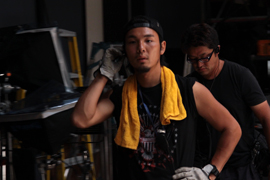
Lighting assistant Yoshitsugu Ochiai (AKA Ochi).
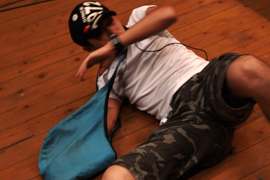
Second Assistant Director Toyohiro Miyata giving some fairly vivid instructions to the actors.

Stylist Kazuki Yunoki’s unit. From left: Manami Ohsumi and Tsuneo Tada. When all of the costumes for the entire cast are put together, it’s a pretty impressive amount.
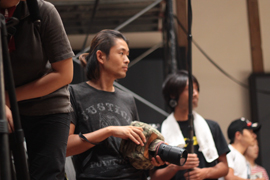
Still cameraman Taka Koike. The hood over his camera muffles the sound of the shutter so that it can be used on set. He made it himself.
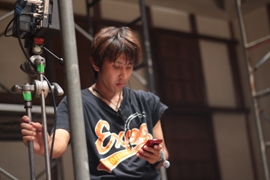
Makoto Miki from Cinematographer Yasutaka Nagano’s team. Our still and movie photographers have combined to form one 6-man unit.
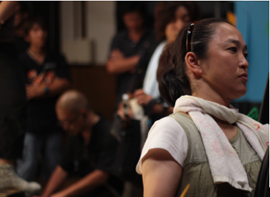
Our crew is composed of members who had previously worked on Yoshihiro Nishimura’s Helldriver. As such, they have a bond formed in the heat of battle on what was allegedly a nightmare of a shoot. “During Helldora (the abbreviated nickname for Helldriver), we never slept a wink and it was raining throughout the entire shoot. It was awful. A once-in-a-liftetime experience,” she tells me.
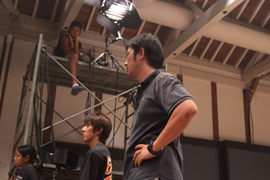
In the front center of this photo is Action Instructor Arata Yamanaka from ZERO’S.

Cast member in a skin tight green suit.
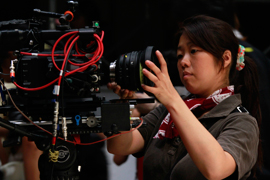
Yasutaka Nagano’s right hand Mami Shimoda. After she’s finihed focusing, she’ll turn to overseeing the camera’s every movement.
Day 8 of shooting.
We’re on location in the same place they shot the music video for one of my favorite songs, Chisato Morisaka’s Watarasebashi. I got a look at Yakumo Shrine as well. I even saw the famous public phone laid conspicuously outside the barbershop! Amazing! Noone could ever tell a story with a public phone as the gimmick these days…
As of today, we’re about one third through the entire 27 day shoot. I’m exhausted but on set, it’s like a festival. Noone seems discouraged at all. Each scene, each shot, keeps moving forward. Nishimura-san keeps shouting “Action, cut…action!” and slamming down the edges of the clapboard.
Second assistant directors Miyata-san and Kosaka-san discuss fine adjustments with Nishimura-san before each scene and communicate them to the actors. Nagano-san looks over Nishimura-san’s storyboards and builds on them, laying out the composition of each shot, changing the camera angle, and sorting out the details of the final layout with the lighting assistants in order to get the proper picture. The sound people capture the dialog and surrounding environment. It’s the pinnacle of collaborative environments. Story, moving images, and art all blend together forming a tapestry. I’m very moved.
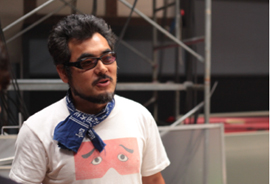
“Demo Tanaka”-san from the making of video. In the past, he was also known as “Drill Tanaka”. When I ask him how he got these names, he responds “Don’t ask me!” He’s from Hakata. He regales everyone with stories about Nagahama-style ramen!
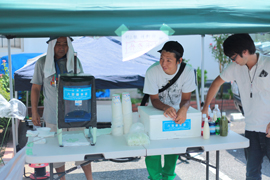
From left, we have vehicle manager Seishi Ochi, as well as production assistants Masato Date and Yuki Nakajima (aka Nakajiiii) . On this day, they handed out snow cones to relieve the heat.
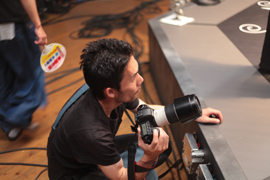
Archival cameraman Shiro Miyake. He’s one of Koichiro Matsui’s team.
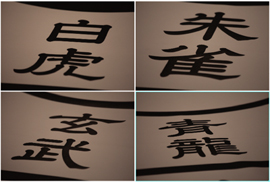
Wha?! What is this?!
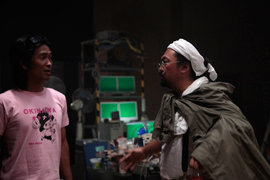
Discussing action with Karasawa-san.
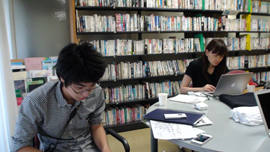
In the front of this photo is Naoka Watanabe from our Modern Visual Information department. He’s been a frequent object of wrath on set. In the corner is Jellyfish Eyes” Kaikai Kiki-side producer Chiaki Kasahara.
It’s the first day of shooting on a built set. I was concerned with a great many things so I’ve been cracking the whip on them all morning. Now it’s time for the main event!
On set, I’ve already been brought to tears by the skills of the actors several times. I even cried during the comedy scenes. I get caught up in imagining each characters’ background and find myself going over each line of dialog in my mind, imagining all the unsaid reasons they say sometimes ridiculous things and end up crying.
What is it that people need from stories. I’ve been thinking about this a lot the past several days. People need an external device that can make them forget about the struggles they go through every day. That device is storytelling. The scale of experiences that an individual can go through in one single life is limited. Even today, in the age of computers, where the internet has linked the world together and we can fly anywhere for a reasonable price, those of here in Japan are still limited to our individual experiences and most of the unforgettable ones are negatives. re is only so much that a single person can experience in one lifetime. Our positive memories form only a tiny speck of our total experience. And to escape that fact, we need stories.
Postwar Japan has a history of eliminating tales which reflect on the darker parts of life. These memories began piling up beneath the surface in hidden, unseen layers until finally they were completely concealed, only to burst forward all at once with the recent disasters. Japanese are beginning to protest the state of things in Japan. I began looking at Japanese stories and thought “everyone has got it all wrong”. This comfortable, superflat country that we call Japan was created entirely by our own hands.
Learning to live, even if it means accepting the worst aspects and the worst periods of life. It’s true that there is much in the world that we cannot be proud of, but getting our hands dirty in the muck of it all is the only way to affect real change.
I want to craft a story that communicate this message to children. No. To all of Japan. They don’t have to listen, but I do have to speak. The movie I’m making is built on this ambition.
And that’s why I become all sentimental watching those miraculous moments when the actors fully embody their roles.